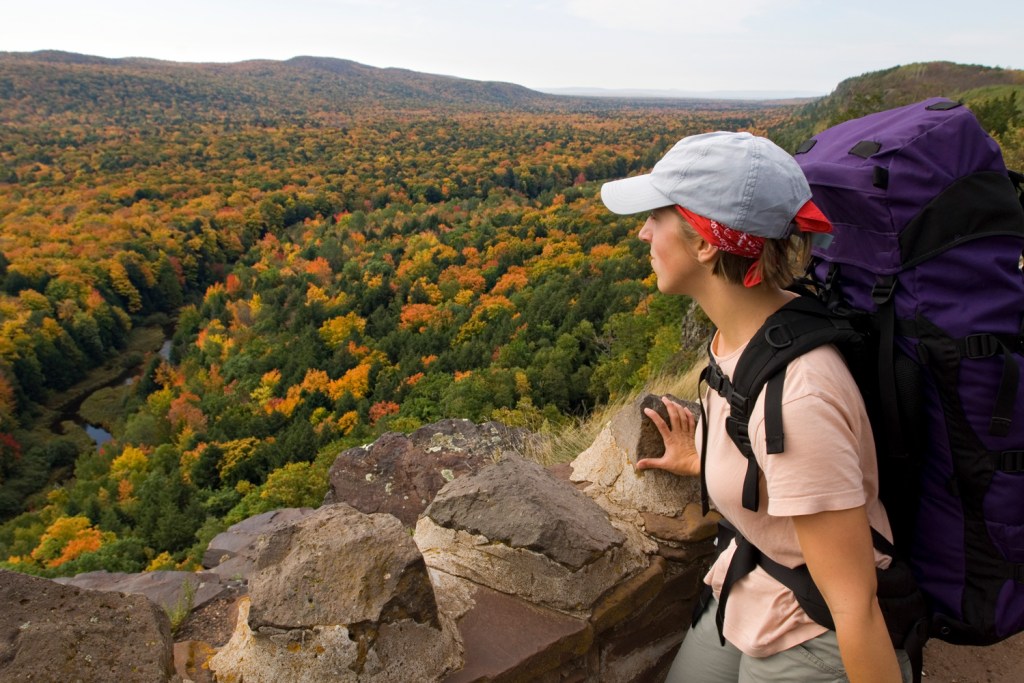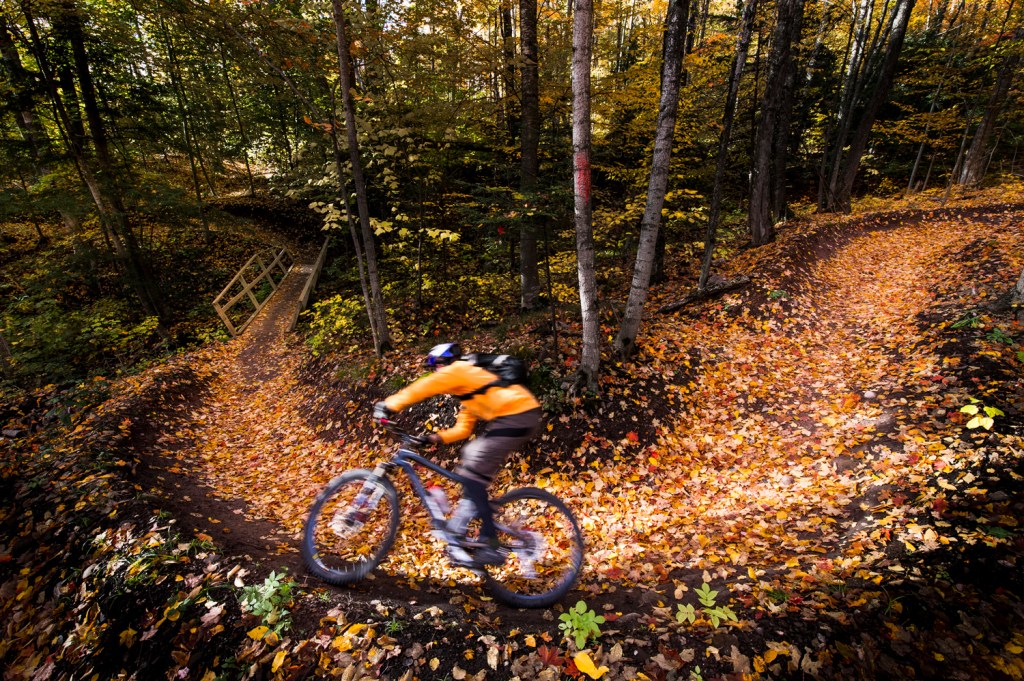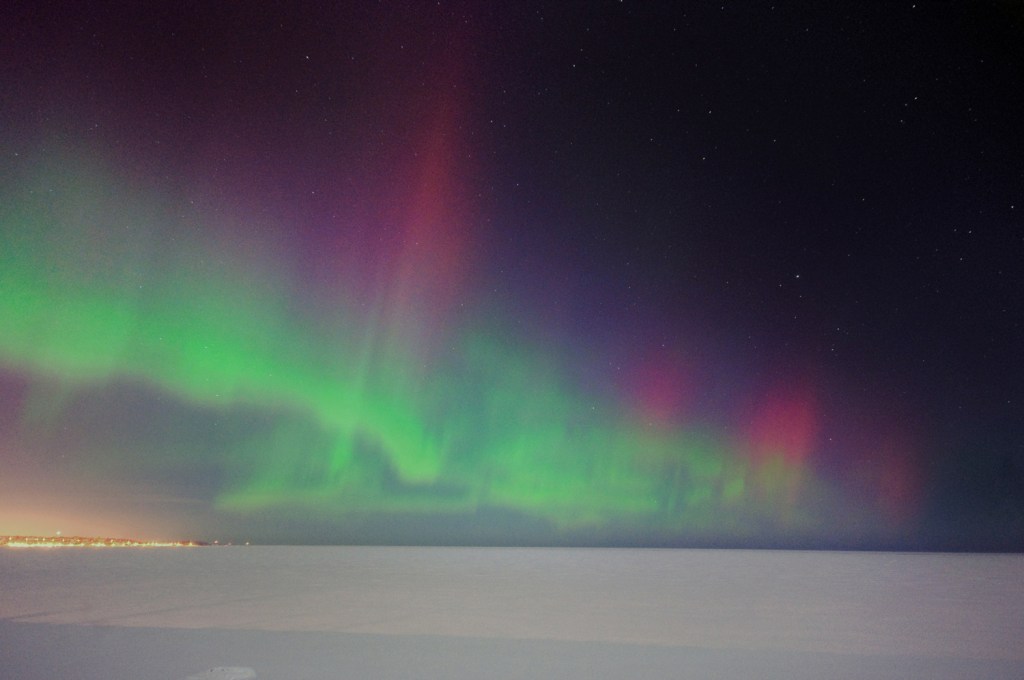Michigan’s Upper Peninsula is truly a wild place, where wolves, moose and elk roam free in dense forests of aspen, maple and pine. Known by locals as the U.P., the region is bordered by three Great Lakes, and is perhaps best known for its harsh winters. In the fall, however, the forests of the Upper Peninsula put on a colorful display that rivals those of the Northeast. Now is the time to hit the road in search of fall colors and adventure in Michigan’s Upper Peninsula, and this guide provides a starting point to get you there.
Things to Do
Hiking
From easy strolls along the shores of Lake Superior to heart-pumping treks to the top of the Porcupine Mountains where you can gaze out over one of the largest expanses of old-growth northern forest in North America, Michigan’s Upper Peninsula holds countless wonders for hikers of all backgrounds and abilities.
Pictured Rocks National Lakeshore
Hailed by locals as one of the best hikes in Michigan, the Chapel Loop traces through Pictured Rocks National Lakeshore along the upper edge of sandstone cliffs that drop hundreds of feet into Lake Superior. Stunning views of the unique geological formations dotting the coastline await. At 10.4 miles roundtrip with easy grades, it’s perfect for a day hike or can be done as an overnight with a stay at the backcountry campground near Chapel Beach. A permit is required for all backcountry camping and can be reserved through the National Park Service. “I can sit there for hours, just watching the water and enjoying the beauty,” says Barb Isom, who manages the area’s North Country Trail, a 4,600-mile footpath from North Dakota to New York that cuts through Pictured Rocks. Among the trail’s highlights are Mosquito Falls and Chapel Rock, a sandstone spire home to a lone pine tree. “I always wonder how much longer that tree will survive,” Isom says. “It always amazes me when I still see it alive.”

A backpacker looks out from the Escarpment Trail above Lake of the Clouds in Porcupine Mountains Wilderness State Park in fall in Michigan’s Upper Peninsula. (Photo Credit: Aaron Peterson)
Porcupine Mountains Wilderness State Park
This park is home to the Porcupine Mountains, which top out at nearly 2,000 feet, waterfalls, lakes and one of the largest expanses of old-growth northern forest in North America. Here, mature maple, birch and basswood change to vibrant hues of red, orange and yellow. Within the 60,000-acre park, there is an extensive network of backcountry trails. Campsite reservations are highly recommended and can be arranged through the park. The Lake Superior Trail offers views of the path’s namesake and at 17 miles in length one-way makes a good overnight option. For a day hike, there’s the Escarpment Trail, an 8.6-mile out-and-back with some elevation gain that unveils views of the rugged mountains, cloaked in a sea of color. Twenty-three miles of the North Country Trail snake through the park as well.
Mountain Biking
The eclectic mountain biking trail systems around the Upper Peninsula deliver something for every rider. From easy grades that offer a simple ride through the woods near Marquette to demanding ones that require a high level of expertise, you can find a trail that’s right for you.
Jutting out into Lake Superior, the Keweenaw Peninsula is covered with wild forest. In recent years, the area has morphed into a mountain biker’s dream, with miles of trails that offer a wide range of challenge. The Copper Harbor trail system has been named a Silver Level Ride Center by the International Mountain Biking Association. This designation recognizes mountain biking communities that offer something for every rider. “On those trails, you ride through old-growth pine forests,” said Bob Hendrickson, publisher of U.P. Mountain Biking, an online resource for biking in the region. “There are some good guiding services there if you don’t have the gear or knowledge of the local trails.” Other popular trails include Churning Rapids, Swedetown Trails and the Michigan Tech Recreational Forest, the latter boasting up to 18 miles of singletrack and widened ski trails among rolling hills.

Mountain biking in fall on the South Trails of Marquette, Michigan. (Photo Credit: Aaron Peterson)
Marquette, with a population around 21,000, is the largest city in the Upper Peninsula and is a destination for mountain bikers thanks to its well-maintained trail systems. “There are quite a few places to ride within a 20-mile radius of town,” Hendrickson says. “People are really involved with maintaining the trails here.” He says one of the best around is the South Trails system, which boasts close to 30 miles of singletrack with a solid mix of beginner lines and technical trails. One of the perks of this ride is that the off-road bike path takes you straight from downtown to the trailhead. While in Marquette, Hendrickson says to check out Harlow Lake, with its views of the surrounding hills, and the North Trails, which offer many beginner options.
Camping
The Upper Peninsula’s large national and state forests serve as perfect draws for camping, whether at designated campgrounds or sites deep in the backcountry. Camping offers the solitude that’s important for experiencing the great northern woods, complete with their spectacular waterfalls and rivers.
This state park is home to one of the largest waterfalls east of the Mississippi River—the awe-inspiring Upper Falls of Tahquamenon are more than 200 feet wide and drop nearly 50 feet. Within the 20,000-acre park, you can hike more than 40 miles of trails in forest dotted with lakes near the wild Tahquamenon River that flows into Lake Superior. There are three campgrounds available with options for electrical hookups, and one primitive campground. The Lower Falls campgrounds are near the lodge and day-use sites, while the Rivermouth Modern and Rivermouth Pines campgrounds provide easy access to Lake Superior’s Whitefish Bay.
At almost one million acres, the Ottawa National Forest encompasses some of the most wild woodlands in the Upper Peninsula, much of it aspen and maple that turn brilliant colors in the fall. There’s no better place to experience the rugged forest than the Sturgeon River Gorge Wilderness, says Lisa Klaus, the forest’s public affairs officer. The area is home to the Wild and Scenic Sturgeon River that has several waterfalls and a 350-foot-deep gorge that’s a mile wide. “The area is perfect to spot fall colors because of the beautiful overlooks,” Klaus says. Within the wilderness area, the Sturgeon River Campground offers nine sites and backcountry camping is allowed. “You can get off the beaten track to where there’s solitude all day,” Klaus says.
Canoeing
With stunning views of rugged shoreline cliffs from the waters of Lake Superior, it’s easy to see why people flock to the Upper Peninsula for canoe trips. But you can also find solace among the forests’ easygoing rivers that snake through a dense canopy of color in the fall.
This 35-mile canoe trail is located in the Hiawatha National Forest, which brims with about 900,000 acres of forest and rivers between Lake Superior and Lake Michigan. The Wild and Scenic Indian River is 51 miles long and the banks of its free-flowing waters provide a habitat for bald eagles, ospreys, the American marten and even wolves. This time of year, it’s a gently flowing river that’s 30 to 50 feet wide with an average depth of one to three feet. At most, it takes two days to complete the paddle, with multiple campgrounds along the way—or it can be paddled in a single day. Due to light traffic this time of year, expect to have the fall colors to yourself.
Following the shores of the Keweenaw Peninsula, this epic 100-mile paddling trail begins at McLain State Park and circles the edge of Lake Superior before ending near Portage Lake. As storms can routinely brew some dicey conditions, this trek is only recommended for experienced sea kayakers. “You have to base your trip around the weather,” says Dan Wiersgalla, senior kayak guide and supervisor for Keweenaw Adventure Company. Wiersgalla says he offers guiding services until Sept. 30, which is considered late in the season, as cold fronts then begin pounding the coast. It will take an experienced paddler about seven days to complete the trek, which passes near jagged shoreline, beaches and small towns, along the way providing excellent opportunities to spot fall colors—but that could be lengthened by bad weather. “That’s just the nature of Lake Superior,” Wiersgalla says.
Top Sights
Experience the Northern Lights
The sparsely inhabited Upper Peninsula means little light pollution, which is perfect for spotting the aurora borealis, says Marquette-based photographer Aaron Peterson. In fall, fewer hours of daylight provide more opportunities to catch this phenomenon when solar activity is high. “The expanse of Lake Superior to the north offers a clean black stage for the aurora to dance across—and reflect in while doing so,” Peterson says. To capture the northern lights, try the Keweenaw Peninsula or one of the parks or national forests. Peterson says you’ll need a camera with manual settings and a tripod—and don’t forget a good headlamp and plenty of warm layers to maximize your time outdoors. Before you go, check spaceweather.com or NOAA to see if conditions are ripe for an aurora.

Aurora borealis over a frozen Lake Superior with the lights of Marquette on the shore. (Photo Credit: NOAA/NWS/NWSFO Marquette, Michigan)
How to Visit
Where to Stay
There’s a campground in just about every corner of the Upper Peninsula. For those looking for a park that seems to offer something for every type of traveler, the Tahquamenon Falls State Park offers primitive campsites as well as those with electrical hookups. It also provides the option to rent a lodge that fits up to 10 people. Backcountry options abound in the Porcupine Mountains, which boasts 63 campsites in remote forest. If you’re looking for a few more creature comforts, the Little Presque Isle State Forest has six cabins to rent with plenty of hiking nearby. Marquette, the biggest town on the peninsula, is the best bet for hotel accommodations.
When to Visit
The trees begin changing colors in the Upper Peninsula in late September and peak fall foliage occurs in mid- to late-October. You can expect hues ranging from rusts to gold to blazing orange. As a bonus, the days are just about perfect, with highs in the 50s and 60s and lows hovering around the 40s.
Travel Planning
The western half of the peninsula is easily accessed by Highway 2 from points west. The town of Marquette is about a six-hour drive on Highway 41 from the major airport in the region, Chicago O’Hare International. The Detroit Metropolitan Airport provides access to the eastern region of the Upper Peninsula—it takes just four hours on I-75 to reach the Mackinac Bridge, which is considered the gateway to the Upper Peninsula. You can also fly into the Sawyer International Airport in Marquette, but fares tend to be pricier.
